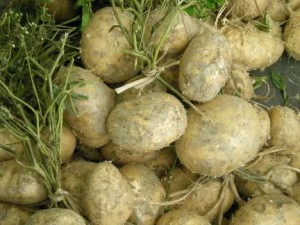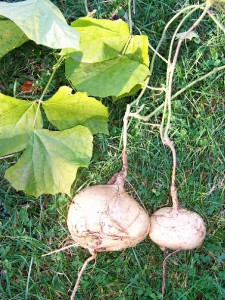 Yam Bean or Jícama in Spanish, is the name of a native Mexican vine, although the name most commonly refers to the plant’s edible tuberous root. Yam Bean or Jicama is one species in the genus Pachyrhizus. The Yam Bean or Jicama vine can reach a height of 4-5 metres given suitable support. Its root can attain lengths of up to 2 m and weigh up to 20 kilograms.
Yam Bean or Jícama in Spanish, is the name of a native Mexican vine, although the name most commonly refers to the plant’s edible tuberous root. Yam Bean or Jicama is one species in the genus Pachyrhizus. The Yam Bean or Jicama vine can reach a height of 4-5 metres given suitable support. Its root can attain lengths of up to 2 m and weigh up to 20 kilograms.
In the Philippines, Yam Bean or Jicama is popularly known as Singkamas and the heaviest Yam Bean or Jícama root ever recorded was found here which weighed up to 23 kilograms.
The root’s exterior of Yam Bean is yellow and papery, while its inside is creamy white with a crisp texture that resembles raw potato or pear. The flavor is sweet and starchy, reminiscent of some apples or raw green beans, and it is usually eaten raw, sometimes with salt, lemon, or lime juice and chili powder. It is also cooked in soups and stir-fried dishes.
When choosing Yam Bean or Jicama at the store, look for medium sized, firm tubers with dry roots. Do not purchase Yam Bean or Jicama that has wet or soft spots, which may indicate rot, and don’t be drawn to overlarge examples of the tuber, because they may not be as flavorful. Yam Bean or Jicama will keep under refrigeration for up to two weeks.
Yam Bean or Jicama is a great source of different vitamins and minerals. In fact, it is an excellent source of vitamin C, fiber, potassium, iron, calcium and is also low in sodium. Moreover, it has no calories or fat—making it a superb on-the-go snack.
Due to its high nutritional value and low jicama calories, this vegetable offers numerous nutritional benefits, of which some are given below:
- Being low in calories and fat, jicama helps to control the cholesterol levels and reduces the risks of having any heart problems like heart attack, hypertension, etc.
- It is high in vitamin C, hence acts as a powerful antioxidant and anti inflammatory. Its anti inflammatory properties benefit by subsiding the symptoms of asthma like wheezing especially in young children and being rich in vitamin C, it helps to cure common cold and flu.
- Deficiency of vitamin C can increase the incidence of bruising in some people. Hence, people who suffer easy bruising can overcome this problem by increasing their vitamin C intake by including jicama vegetable in their daily diet.
- Jicama also benefits by strengthening or supporting the structure of capillaries, thereby reducing the risks of having capillary fragility or damage.
- Being rich in folic acid, beta-carotene and many other vitamins, jicama is quite effective in lowering the homocysteine levels in the body. Homocysteine is an amino acid that affects the cellular metabolism and production of proteins in the body and can also increase the risks of heart disease by damaging the lining of blood vessels. Moreover, studies show that people who eat jicama regularly, are found to have 11 percent lower homocysteine levels as compared to those who don’t eat this vegetable.
To sum up, Yam Bean or Jicama basically boosts the body’s immune system and helps in enhancing the overall body functioning.
How to grow Yam Bean or Singkamas
Origin and Distribution
The Yam Bean or Jicama appears to have originated in Mexico and northern South America, in the head-water region of the River Amazon, and was cultivated there in pre-Columbian days. The Spaniards took it to the Philippines and it is now cultivated and naturalized in the Philippines, Cambodia, China, Indonesia, northern India as well as in western and northern South America and the Caribbean.
Cultivation Conditions
The Yam Bean or Jicama is tolerant of various climates, but for optimum yields it requires fairly high temperatures and a moderate to high rainfall: it grows well in the hot, wet tropics. In Mexico, it is grown under irrigation and in the cooler areas has a longer vegetative cycle. It is normally grown at altitudes below 1000 m.
Soil-a well-cultivated sandy loam soil with adequate drainage is essential; it will tolerate well-drained clay soils, but not heavy soils liable to become waterlogged. For high yields, the application of a 12: 24: 12 NPK fertilizer at the rate of 300-400 kg/ha before planting has been recommended, followed by 200 kg/ha of ammonium sulphate when the plants begin to climb. In addition, if the soil has been heavily cropped it is suggested that it should receive 10 t/ha of compost or FYM, about one month before planting.
Day-length-short days are necessary for tuberization. When grown under a 14-15 hour photoperiod the vegetative growth is good, but there is little production of tuberous roots: short day-length gives smaller, more bushy plants and good tuberization.
Planting Procedure
- Material – the Yam Bean or Jicama is grown principally from seed, but it can be grown from sprouted roots saved from the previous crop. It has been recommended that this practice be followed to maintain desirable characteristics in the plants.
- Method – the seeds are normally sown at the beginning of the rains, either on the flat or in ridges; the latter gives better results. Usually 2-3 seeds are placed in each hole and the plants thinned out as necessary, or the seeds may be planted singly by drill. The provision of bamboo trellises about 2.5 m high to support the vines has been found beneficial, but is not essential. The crop is kept free from weeds and is often mulched to help conserve soil moisture and prevent weed growth. Sometimes the plants are stopped or pruned in order to encourage vegetative growth and the removal of the flowers is reported to increase tuber yields and improve their flavor.
- Field spacing – recommended seed spacing for India is 15 cm along rows 50 cm apart; in the Philippines, a spacing of 10 cm in rows 15-20 cm apart is common practice, although it has been shown experimentally that the yield of roots doubled when a spacing of 15 x 15 cm was used.
- Seed rate – in the Philippines, 20-25 kg/ha of seed is used for planting, assuming a germination rate of 90-95 per cent. In India, a higher seed rate, 50-70 kg/ha, is preferred.
Pests and Diseases
In Central America, the Yam Bean or Jicama is reported to be subject to attacks from the larvae of Thecla jebus and Ferrisia virgata. In Mexico, the seeds are often attacked by weevils. In the Philippines, a mosaic disease has been noted, which is caused by a systemic virus, transmitted through the seed or root. A slight mottling or chlorosis and blistering of the leaves, together with the production of very small tubers are characteristic symptoms. A bacterial leaf spot caused by Pseudomonas syringae has also been reported.
Growth Period
The crop normally reaches maturity in 5-8 months, although in the warmer parts of Mexico a commercial crop is obtained in about 3 months. If a seed crop is required, the growing period is approximately 10 months.

Harvesting and Handling
The roots are usually dug manually, though with large-scale production they are sometimes ploughed out. The tops are trimmed or removed entirely and the roots washed and packed in baskets for market. Within 24 hours the creamy color of the skin changes to a purplish-brown, but this can be arrested if the roots are stored in the dark at 9-10°C. They can be stored successfully for at least 2 months at temperatures just above 0°C; older roots tend to store better than tender immature ones. They can also be ‘field-stored’; in Mexico, the normal practice is to withhold irrigation water thus stopping growth and the roots remain in good condition in the soil for 2-3 months. Just prior to lifting they are irrigated and absorb water, and can be marketed in the usual way.
Primary Product
Tuberous roots-which, as normally harvested, are 10-15 cm in diameter and weigh up to 2-2.5 kg: they have a creamy surface and white, rather watery flesh. At this stage they are crisp and succulent, with a pleasant, sweet flavor. If left to grow they increase in size and can reach 30 cm in diameter and weigh 5-18 kg, but they become tough and unappetizing. The tubers of P. tuberosus are rather larger.
Yield
Average yields of tuberous roots are about 7.5-20 t/ha, although yields as high as 95 t/ha have been reported from the Philippines and Indonesia.
Recent trials have shown considerable differences from cultivar to cultivar and cv. Rajendra Mishrikand-l has been reported from India to average 40 t/ha (twice the normal yield).
Main Use
The young tubers are eaten raw in salads, or cooked as a vegetable, or in pickles and chutney. They are popular among the lower income groups in parts of Latin America and the Caribbean. In the USA they are becoming increasingly used, both for eating in their own right and as a substitute for Chinese water chestnut.
Subsidiary Uses
As the roots mature their starch content increases and older roots are sometimes used as a source of starch or for animal feeding. In China, the dried roots are reported to be used as a cooling food for people with fever.
Secondary and Waste Products
- Seed pods – the young seed pods of P. erosus are sometimes eaten as a cooked vegetable, similarly to French beans, but cannot so be used as the seeds develop. The crushed pod of P. tuberosus, mixed with lard, is used in China to cure itch.
- Seeds – the powdered seeds are sometimes used as an insecticide or fish poison. In Indonesia, the pulverized seeds mixed with Sulphur are applied to certain types of skin eruption. One half seed may be taken as a laxative, though it is stated that if poisoning occurs coconut water will counteract it. It is, however, reported that the oil in the seeds resembles cottonseed oil and may be used for cooking.
- Stems – the stems yield a tough fiber, which is sometimes used for making fishing nets in Fiji.
- Animal feed – it has been reported that the whole plant is sometimes used as fodder, and is best for this purpose when harvested at the 50 per cent flowering stage; however, the leaves and seeds are both toxic (the leaves less so than the seeds) and grazing among mature plants can be fatal to animals.
- Green manure – the whole plant is sometimes ploughed into the soil as a green manure.
Tips & Warnings
- In tropical climates, it takes three to six months for Yam Bean or Jicama to develop usable roots, depending on the temperature and amount of rainfall.
- If you want to hide an ugly fence or garden shed, Yam Bean or Jicama vines will quickly cover it up.
- Sandy soil with few rocks is the best choice if you want your Yam Bean or Jicama to develop smooth roots.
- Store your Yam Bean or Jicama dry at between 53 and 60 degrees F, because colder temperatures will damage the root. If you store fresh root at this temperature range, it will keep for up to two months.
- Yam Bean or Jicama offers success to most gardeners, as it is virtually insect-free and disease-resistant.
- Never to eat the seeds. They contain toxins that can make you very ill.
Sources: Kanika Khara, www.buzzle.com, Wikipedia.org; Photos: Wikipedia.org